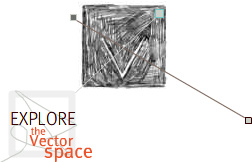Mobile Figures
Design by Erik Loyer
Designer's Statement
From the outset it was clear that David Lloyd, self-described "technopeasant," had been ready for quite some time to write through a database. One of the joys of this project was working to create an environment that would accommodate his almost gleeful willingness to remake his scholarly work using the tools of interactive media.
Interactive projects like this one, whose content begins life in another medium, are inevitably about "slice and dice," or how to chop up the content into atomic chunks that can be tagged, sorted and categorized. This must be done so that the computer can have some "understanding" of the content and thus react intelligently when the user interacts with that content. The process is often accompanied by an understandable fear on the part of the author. Not in David's case, however, and for this I'm grateful, not just because his adventurousness made our collaboration easier, but also because it allowed me to focus on the more constructive aspects of the design. In other words: now that we've atomized the content, how do we put it back together?
Quite early on we decided that the database design would lead everything else, and after a few initial meetings, the structure of the piece's content as a collection of annotated nodes and threads started to suggest itself. Very quickly, and with minimal visual exploration having been done, we had the database up and running, along with a set of entry tools created by Craig Dietrich, to whom both David and I are heavily indebted.
At this point, David was able to begin entering his content directly into the database, while I developed the functionality and look of the piece simultaneously. It was a tremendously liberating, if somewhat frightening, way to work. Allowing for maximum flexibility, the database was intentionally loaded with more structures than we would be likely to use, and those structures could be fruitfully interpreted in multiple ways by the program I was writing. Often David and I would wind up in extended e-mail discussions about the particulars of how this or that piece of data should be entered by him and acted upon by the piece. At times it felt as if we were swimming through endless layers of abstraction, looking for resonances even down to the level of the meaning of individual words—anything that would be a useful foundation upon which to build our lattice of content.
This process of construction was for me the most enjoyable and fruitful part of the project, because it was fundamentally about revealing aspects of David's work that might previously have remained buried, owing to the demands of linearity. This unearthing of process as well as of content was, I think, mutually encouraging: at the end of one meeting David mentioned that he eventually wanted to use the database to write poetry. Since enabling writing is, in a way, the central mission of Vectors, hearing a comment like that couldn't have made me happier.
-- Erik Loyer



